
The ASUS ROG Phone 9 and 9 Pro are the gaming phones to beat — offering exceptional performance, multi-day battery life, and a suite of features to level up your gaming. It's still not quite in the same league as mainstream flagships for photography and software, but the ROG's new AI and camera feature means you won't feel like you're missing out on much.
Parting with the cash for a premium phone is a tough call in today’s economy, especially with hardware advancing at a relatively slow pace. It’s even harder for gaming phones to justify that extra cash, given other Snapdragon 8 Elite phones will be on the market soon enough, even if they’re not quite as fast. Not to mention that there are often so many more compromises in the gaming phone niche.
Thankfully, the ASUS ROG Phone 9 series bridges the mainstream gap better than most, and while I definitely missed a few familiar Pixel features during my time with the ROG, I wouldn’t say that the latest iteration of ASUS’ experience felt miles behind. ASUS has two models on sale this year. The ASUS ROG Phone 9 costs $999, while the Pro model starts at $1,199 and hits $1,499 for 1TB storage and a bundled AeroActive Cooler X Pro — I’ve been testing out the Pro version for over a week now. Let’s get our game on and see if I can be convinced that the promise of higher frames and peak mobile gaming features is actually worth the cash.
The ASUS ROG Phone 9 and 9 Pro are available in Taiwan, China, and Hong Kong at launch. Pre-orders are also available in Europe through ASUS's online store and select retail partners, with shipping slated for early December. The US is scheduled for a later launch date, likely in January 2025.
How does the ASUS ROG Phone 9 Pro perform?
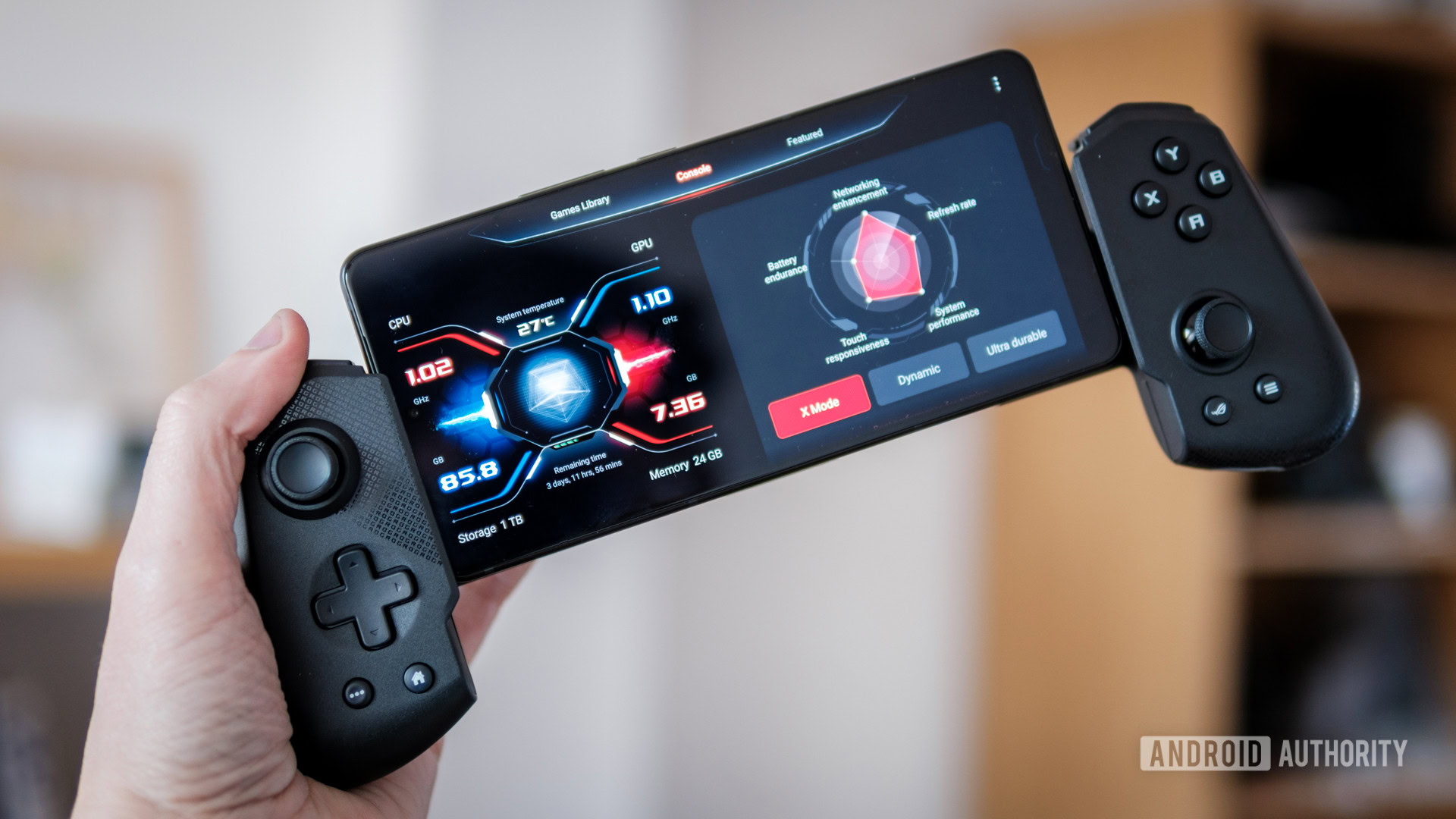
Robert Triggs / Android Authority
Let’s cut to the chase and get to what you really want to know: how well does the Snapdragon 8 Elite-powered ROG Phone 9 Pro actually perform? After all, ASUS has done some solid work to bridge the gaming and mainstream phone divide without falling between the two (and we’ll get to that), but the big reason to buy a gaming phone remains performance.
Running through our usual benchmark suite, it’s clear that the ROG Phone 9 Pro delivers the sort of high-end performance you’d expect. Interestingly, ASUS’ default balanced performance mode is more conservative, ensuring longer battery life and lower temperatures. X-Mode unleashes the chip to run at full tilt.
There’s an odd quirk in the stress test results, though. Prioritizing temperatures produces very aggressive throttling in the default balanced profile, actually lowering performance below the ROG Phone 8 Pro once the phone hits about 33°C (91.4°F). This ensures the handset remains cool and runs for a long time, but it does suggest the Snapdragon 8 Elite runs pretty hot when unleashed. This is further supported when toggling on X-Mode, which lowers peak GPU performance by about 13%, likely to reduce temperatures and help sustain performance over the longer term. Still, the chip clearly has a ton of performance on offer, but what does all this actually mean for your games?
For some real tests, I ran the demanding Genshin Impact maxed-out with a 60fps cap, PUBG Mobile at HDR settings with Extreme (60) fps and 4x AA, the fast-paced F-Zero GX on the Dolphin Emulator using the Vulkan API, and COD Mobile set in 120fps mode. Both phones were set with Performance mode (ASUS’ X-mode) enabled, as this automatically triggers for most titles. To compare the benefits of the new chip, I grabbed the ASUS Zenfone 11 Ultra, a slightly more mainstream version of the ROG Phone 8.
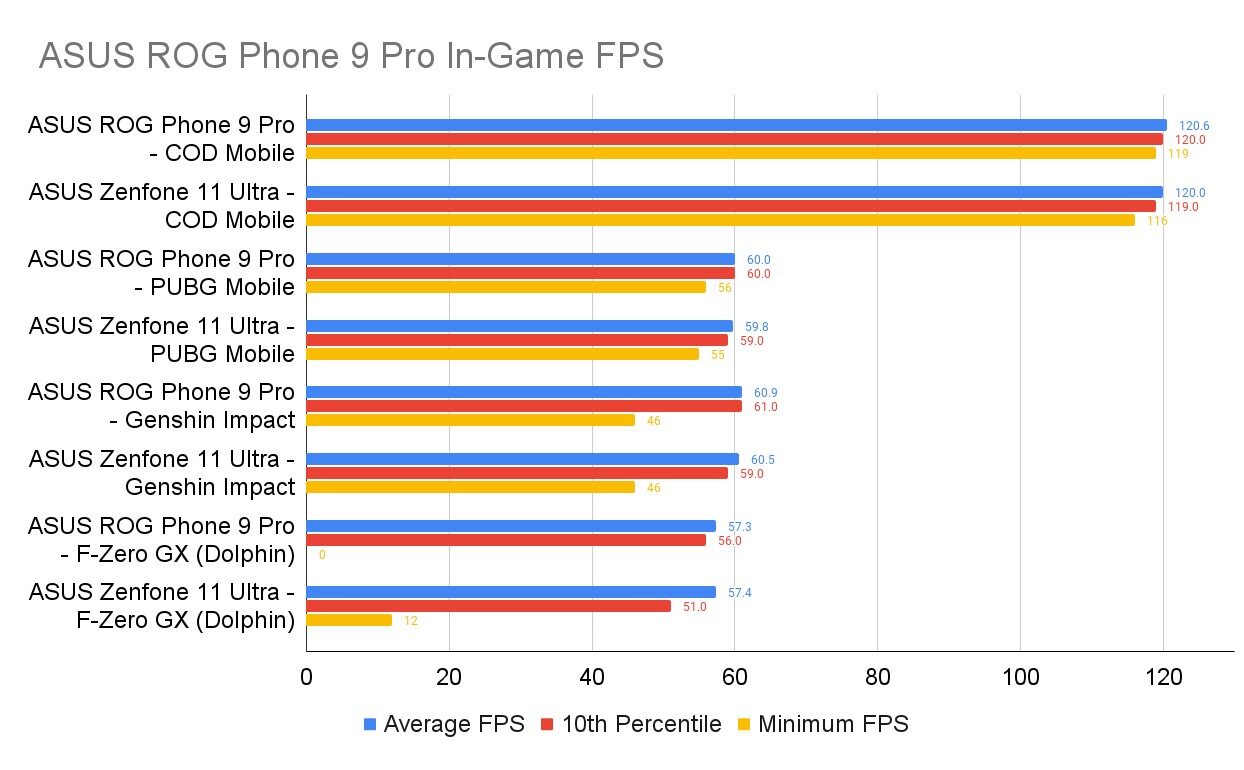
Robert Triggs / Android Authority
The good, but perhaps obvious, news is that the ASUS ROG Phone 9 Pro performs brilliantly. However, for popular titles like COD Mobile, PUBG Mobile, and Genshin Impact, there are only subtle differences in performance compared to last-gen. Average FPS figures are closely locked to 120fps or 60fps and, when the games occasionally stagger, they fall to similar lows as well. However, looking at the 10th percentile (the FPS value that 90% of data points match or exceed) shows that the ASUS ROG Phone 9 Pro and its Snapdragon 8 Elite processor stick to 120fps and 60fps marginally tighter and drop marginally fewer frames.
This difference is more keenly seen in the most demanding gaming workloads — emulation. Again, both phones offer a similar average FPS and stutter quite badly at times, but the 8 Elite holds up better when we look at the top 90% of FPS values. While it did drop to 0fps while moving between menus, it spends less time overall at low FPS values and provides a smoother experience most of the time you’re gaming.
The Snapdragon 8 Elite is marginally smoother in real-world games than the 8 Gen 3, but it's tough to notice.
Equally, I recorded far fewer janks and lower jank durations with the Snapdragon 8 Elite across all four games. Again, emulation showcases this difference more keenly, with jank durations below 30ms compared to over 200ms on the 8 Gen 3 phone.
In summary, upgrading to a Snapdragon 8 Elite doesn’t make a huge difference to the maximum frame rates you’ll find when playing the most demanding Android games; last year’s model was already plenty capable. Though it is, obviously, more future-proof, making it a solid pick if you’re planning on keeping the phone for many years. Importantly, the new chip makes the ROG Phone 9 Pro a little bit smoother and irons out those rare janks. But you’ll have to be an extremely picky gamer to notice.
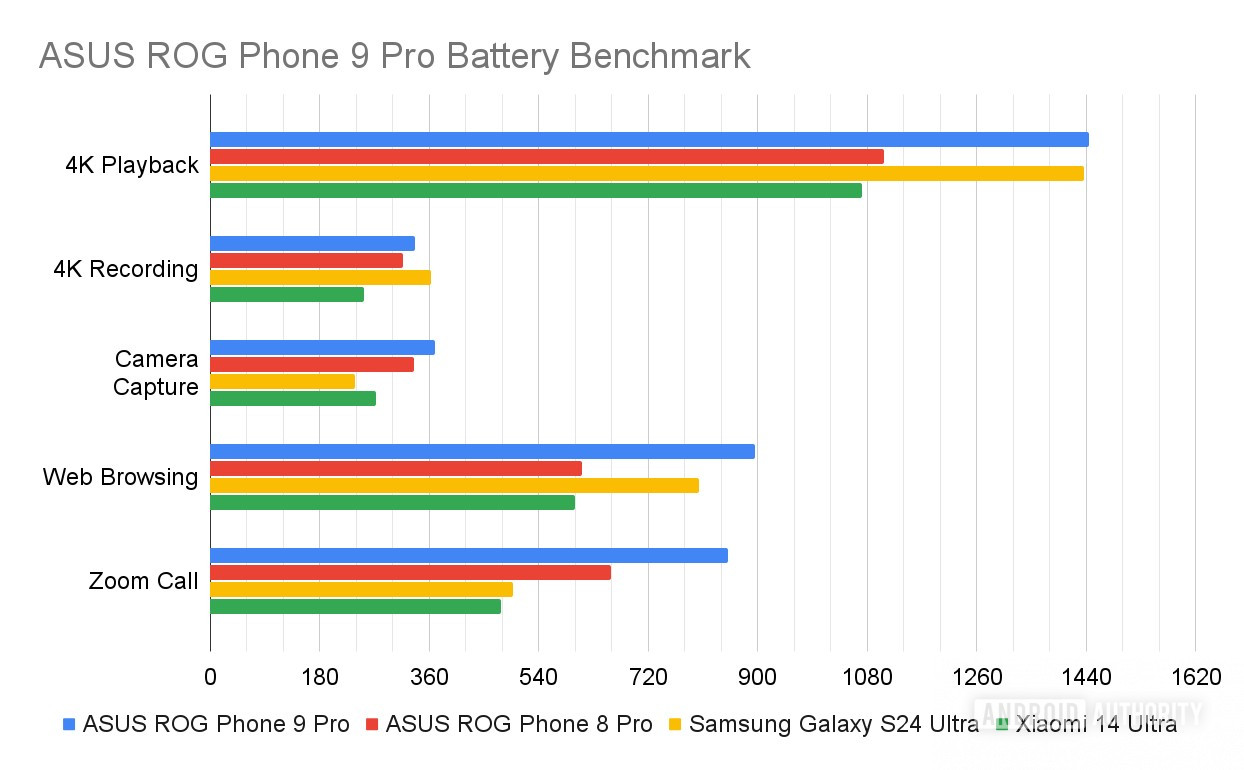
Robert Triggs / Android Authority
While we’re looking at processor figures, it’s worth talking about the huge power efficiency gains from the Snapdragon 8 Elite. The ROG Phone 9 and 9 Pro have a slightly larger 5,800mAh battery (up from 5,500mAh), yet in my tests, the 9 Pro saw a roughly 30% battery life improvement for 4K playback and Zoom calls, while web browsing sees a colossal 46% gain over its predecessor. That’s hours more screen on time that takes the phone well past last year’s model, the Xiaomi 14 Ultra, and even the fairly frugal Samsung Galaxy S24 Ultra in most of our tests. Of course, these brands will have their own Snapdragon 8 Elite-equipped phones in the market soon enough and will probably see substantial gains of their own. For gaming, ASUS reckons you’ll see an average of about 24% less power consumed across the four games it tested.
The ASUS ROG Phone 9 Pro runs games virtually flawlessly, so you can game for longer and complete all your other daily tasks without ever worrying about battery life. When you do run out of juice, the phone’s familiar 65W wired charging capabilities will have you back on your feet in a little over 45 minutes. You can also charge wirelessly at 15W, but that’s much, much slower to fill up.
Is the ASUS ROG Phone 9 Pro a gaming phone I actually want to use… as a phone?
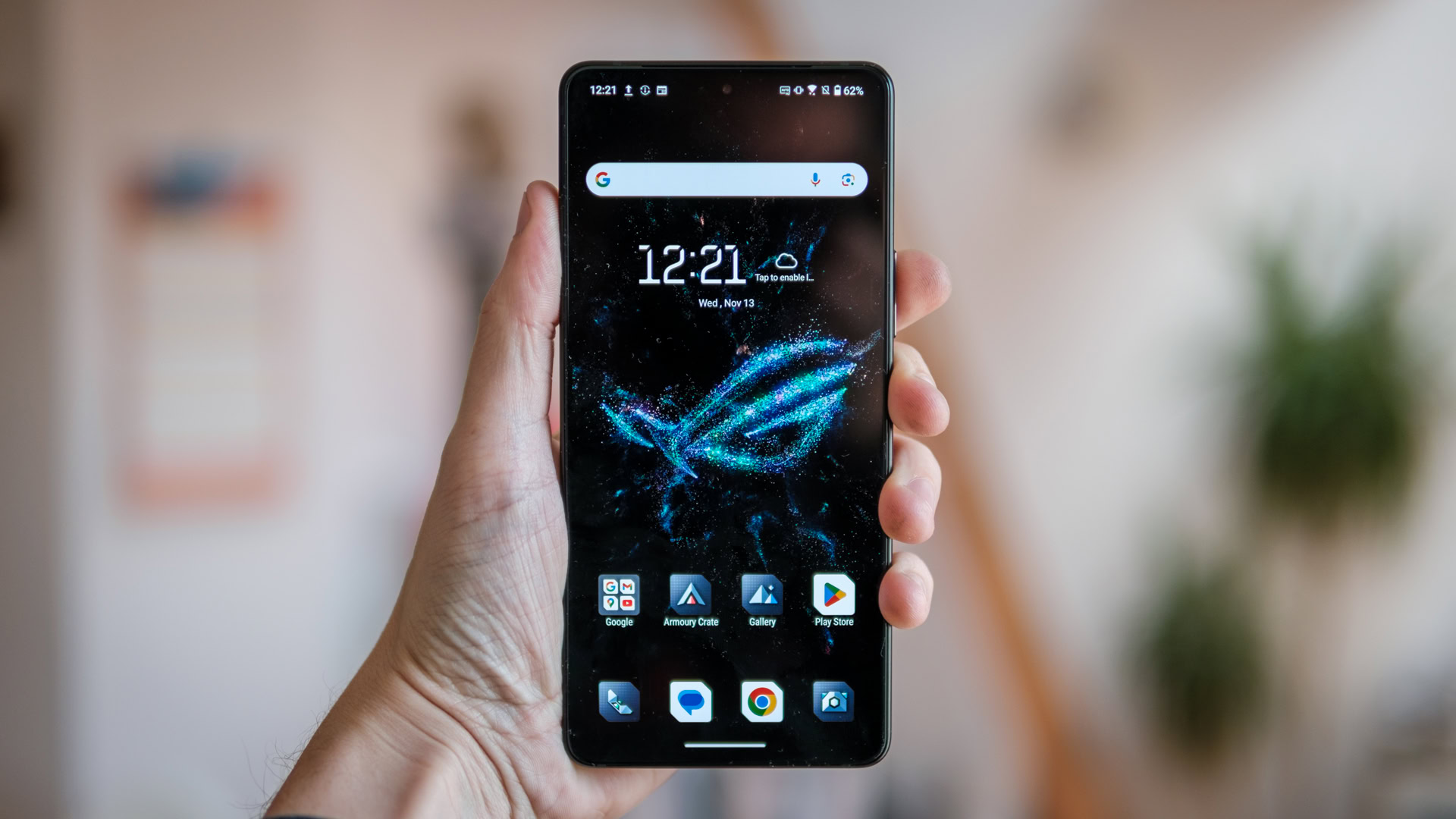
Robert Triggs / Android Authority
From a hardware perspective, outside of raw performance, a few things have changed — the new processor and larger cooling solution being the big ones, but we’ve covered those. As mentioned, both the ROG Phone 9 and ROG Phone 9 Pro have a larger 5,800mAh battery that will easily last all day for regular tasks and several hours of solid gaming, and they still charge to full quicker than a rival Galaxy or iPhone. The display can now hit 185Hz in select games when enabled in ASUS’ Game Genie software and has a peak brightness of up to 2,500 nits. There’s also a Lytia 700 50MP main image sensor (the same size as the previous generation) and improvements to ASUS’ hybrid gimbal stabilizer with ±5° motion compensation. That’s plenty of tweaks, but if you liked the ROG Phone 8 Pro (which I did), a lot of the same pros and cons still apply.
The ROG Phone 9 and ROG Phone 9 Pro make subtle improvements to the formula.
The camera, for instance, has virtually the same strengths and weaknesses as the ROG Phone 8 Pro. Colors range from vivid to washed out, with ASUS’ HDR technique sometimes struggling to balance strongly backlit scenes correctly. The smaller and lower dynamic range ultrawide and the Pro’s 3x telephoto zoom cameras (the regular model has a macro camera instead) are most often at fault here, and the ultrawide suffers from lens flare and edge distortion too. Speaking of zoom, ASUS lets you reach out to 30x, but details look messy well before then. 10x is not usable for anything other than a throwaway social share, and even the native 3x optical zoom appears overly denoised. Even details from the 1x main sensor are oversharp and/or grainy at times. You can see the full-res samples in this Google Drive folder.
Not that I dislike the camera package, but it’s certainly not the best at this price and remains a step down from my experiences with Pixel and Galaxy flagships. Still, ASUS has made gradual improvements over the years that make the setup serviceable, at the very least, and I’m pretty happy with most of the pictures I took. Get past the sharpening pass, and the RGBW selfie camera holds up pretty well in tricky lighting. Likewise, all three lenses offer robust white balance and autofocusing capabilities. ASUS throws in dedicated night, panorama, pro, slo-mo, time-lapse, light trail, and AI panning shooting capabilities, and four new color profiles, putting it right in the mix for creativity options. Imaging clearly isn’t an afterthought with the ROG Phone 9 series.
ASUS’ brilliant gimbal stabilization remains a cut above for video, ensuring even portrait videos look super steady (it kept up with my wobbly toddler). The Hypersteady option remains limited to 1080p, but you’d have to be shooting on the high seas to need this option. You can now have the best of both worlds with ASUS’ new Adaptive EIS mode, which automatically adjusts the video field of view and stabilization depending on the amount of motion. 8K/30 and 4K/60 HDR are accounted for as well, but you can’t shoot 4K on the telephoto and are limited to 30fps on the ultrawide.
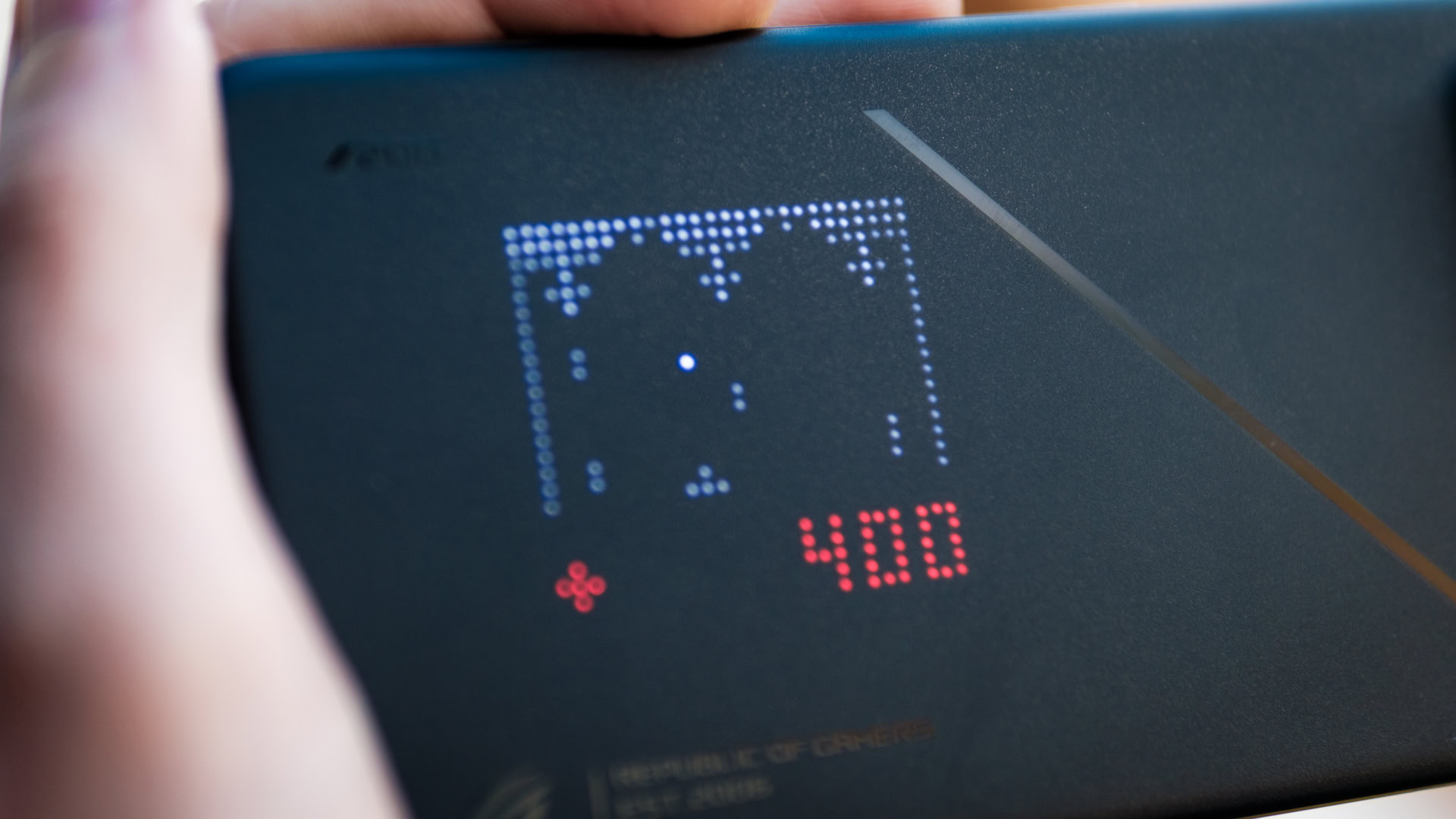
Robert Triggs / Android Authority
ASUS has a few other tricks up its sleeve to tempt you. If you liked last year’s AniMe Vision customizable backlight, it’s enhanced on this year’s Pro with almost double the resolution — now with 648 dots — and a larger area. I don’t spend a lot of time looking at the back of my phone, especially when it’s in a case, so I think this feature is not all that useful. Still, it now supports four retro-arcade-inspired games on it, which is sorta cute. The regular ASUS ROG Phone 9 also sees a slimmed-down version, quite literally, with 85 dots to display notifications and the like, meaning you can grab some of the benefits for a lot less money. The speaker setup continues to sound brilliant, too, even though it’s still easy to block that bottom port with your hand while gaming.
More than a gaming phone; the ROG Phone 9 is packed with AI and photography treats too.
Not to be left behind in the AI race, ASUS brings several features that previously debuted with the more mainstream ASUS Zenfone 11 Ultra. AI Call Translator, AI Transcript, AI Wallpaper, Semantic Search for Gallery and Settings, and Circle to Search (coming in a Q4 update) makes for a pretty useful feature set, even if it’s not quite as broad as Google’s AI ecosystem. Again, this isn’t enough to make me want to drop my AI-leading Pixel, but after installing the Gemini app, the gap certainly felt a lot smaller.
Of course, ASUS continues to imbue its software with gamer-oriented features for supported titles. X Capture uses AI image recognition to automatically capture my admittedly few victory moments, Auto Skill Upgrade remaps buttons when you level up in Arena of Valors, MLBB, League of Legends Wild Rift, and there’s still X Sense to simplify chores like auto-running and speeding up conversions. I found AI Grabber more useful as it doesn’t depend on the title and can quickly search and even translate text on the screen, but the web-view aspect ratio looked a bit broken in-game. Of course, ASUS’ Armory Crate still lets you tweak performance profiles, AirTrigger and key mapping, macros, and more for every game in your library. ASUS might be bringing more mainstream features, but it hasn’t forgotten about its core identity.
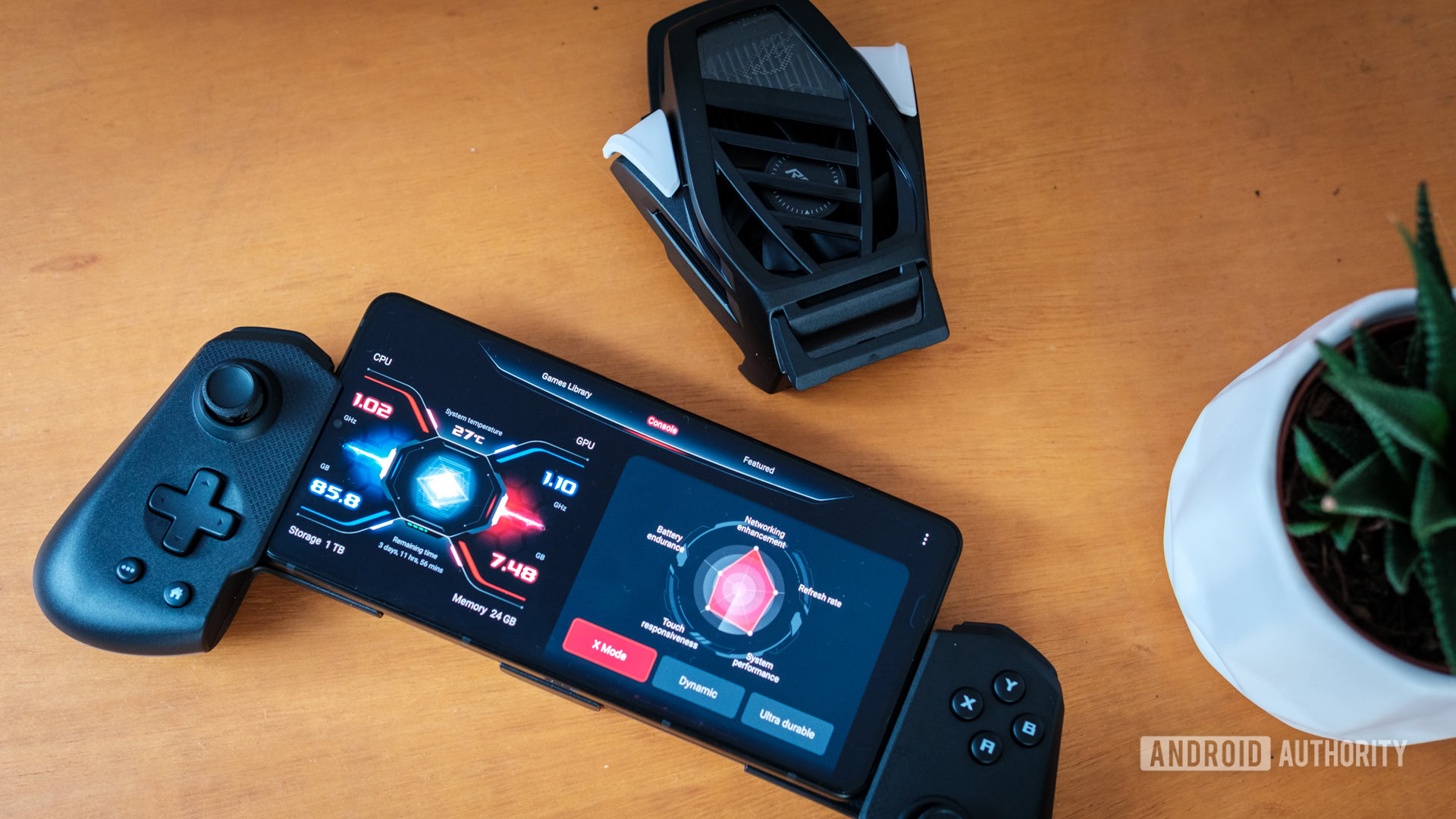
Robert Triggs / Android Authority
Speaking of software, ASUS has promised “at least” two major OS upgrades and five years of security updates, essentially giving the new model an extra year of secure use. The phone will keep running for a while then, but this commitment is still well behind mainstream flagships in terms of OS upgrades. It’s not great when you can spend $1,499 on the top-tier model and factor in ASUS’ historically slow times to provide what few updates do come down the pipe.
ASUS' cooling and game-pad accessories take your gaming up another level.
ASUS also has gamers well-covered for accessories. There’s a new AeroActice Cooler X Pro that boasts 12.5.% larger fan blades for better cooling and a substantial boost to bass audio quality and loudness, thanks to a built-in subwoofer. Although the phone has the same dimensions as last year, you can still use last year’s Cooler X. I’m a big fan of ASUS’s reasonably new Tessen mobile controller, which made running all those gaming benchmarks much more fun than wrestling with touchscreen controls. The fold-up design keeps it super portable, it features a huge range of customization options, and the joysticks and paddle triggers feel great. Unfortunately, ASUS didn’t have pricing for these peripherals at launch.
ASUS ROG Phone 9 review: The verdict
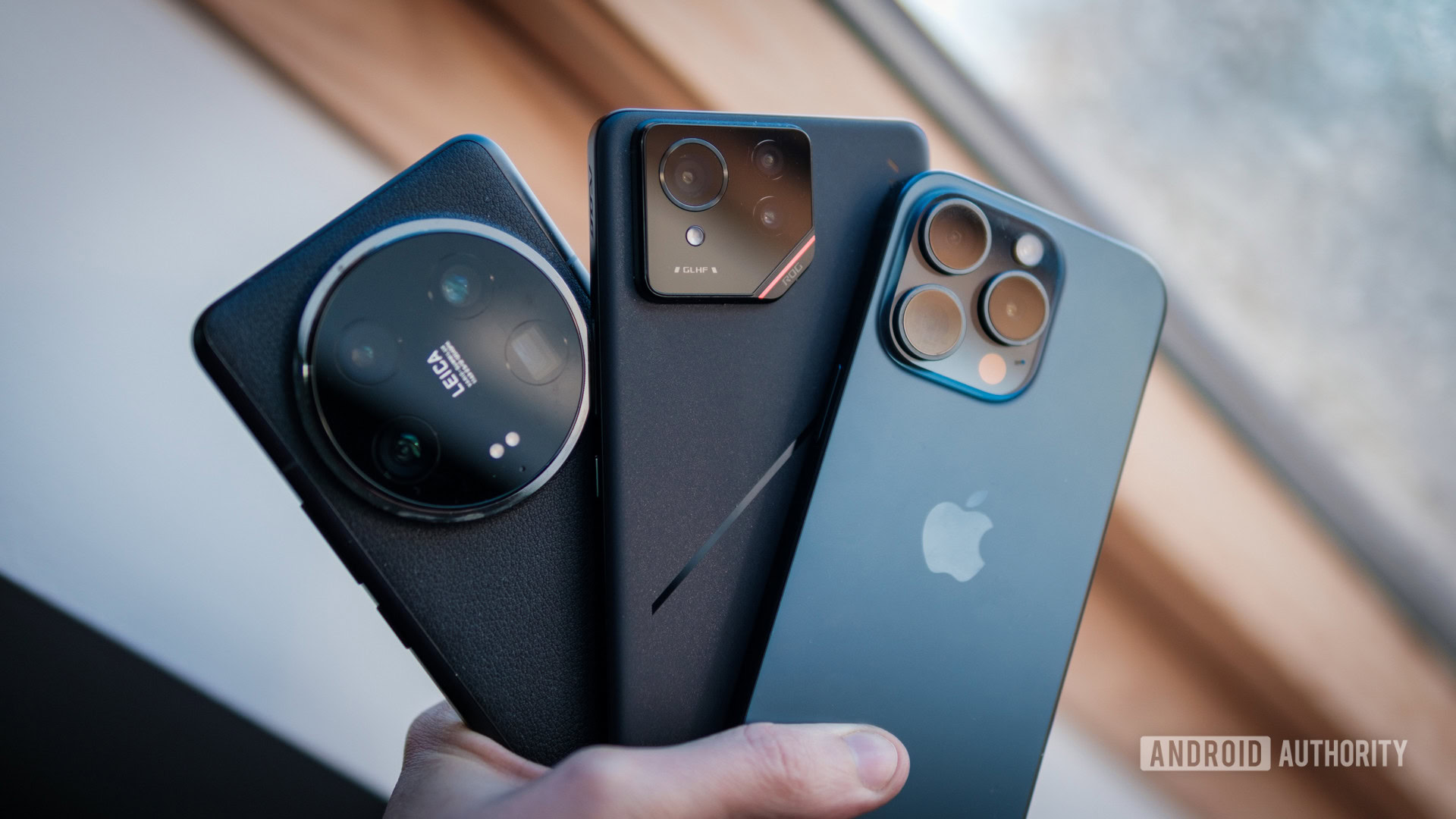
Robert Triggs / Android Authority
ASUS is well known for making exceptional gaming phones, and if you’re looking for bleeding-edge performance, the ASUS ROG Phone 9 and 9 Pro are hard to beat. However, I don’t think existing ROG Phone 8 customers should rush out to grab this year’s models for these improvements alone. Those on the 6 or 7 series will see bigger upgrades, however.
Still, ASUS has built a solid phone here that continues to blur the lines between those old, gaudy gaming phones and something that has more mainstream appeal. You’ll still only want the ASUS ROG Phone 9 or 9 Pro if you’re primarily buying a phone for gaming, as rivals have it beat in the camera and software features departments. But ASUS’ photography and AI tools mean you won’t feel like you’re missing out on too much while still benefiting from the series’ brilliant performance, gaming features, and accessories. This is definitely a gaming phone I can happily use as a daily driver, especially because of the superb battery life and brilliant charging.
The ROG Phone 9 series' brilliant battery life, AI tools, and decent cameras make for a pair of gaming phones that don't compromise.
Between the two models, I’d buy the ROG Phone 9, as it offers all the performance of the Pro model and trims down the optional AniMe Vision lighting, which I don’t think is worth that extra cash. That said, the Pro model is the only way to get the 1TB storage option, which is handy if you’re playing several different high-end games at a time, and the 3x camera adds a lot more versatility if you’re going to be taking a lot of snaps.
It’s still early days for Snapdragon 8 Elite phones, and it’s worth waiting to see how rival handsets perform too. The Samsung Galaxy S25 Ultra is only a few months away, and the OnePlus 13 and Xiaomi 15 series are coming too. While they won’t have the gaming extras that only a ROG can provide, they will still likely offer blazing-fast performance for most gamers and will come with the photography, AI features, and long-term updates that ASUS is still slightly behind on.

ASUS ROG Phone 9
Overkill performance
Outstanding battery life
Fast, universal charging

ASUS ROG Phone 9 Pro
Overkill performance
Outstanding battery life
Fast, universal charging

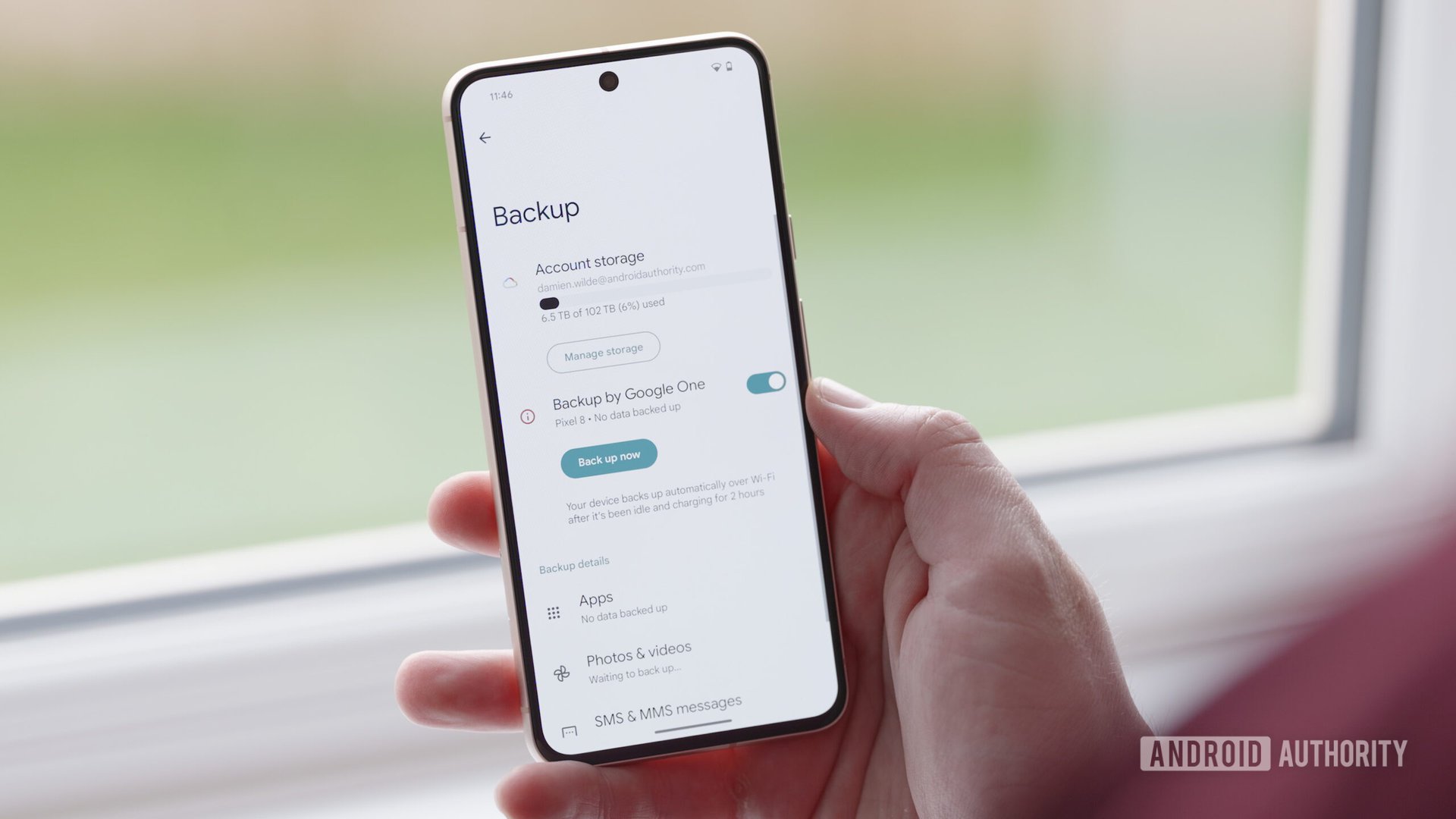
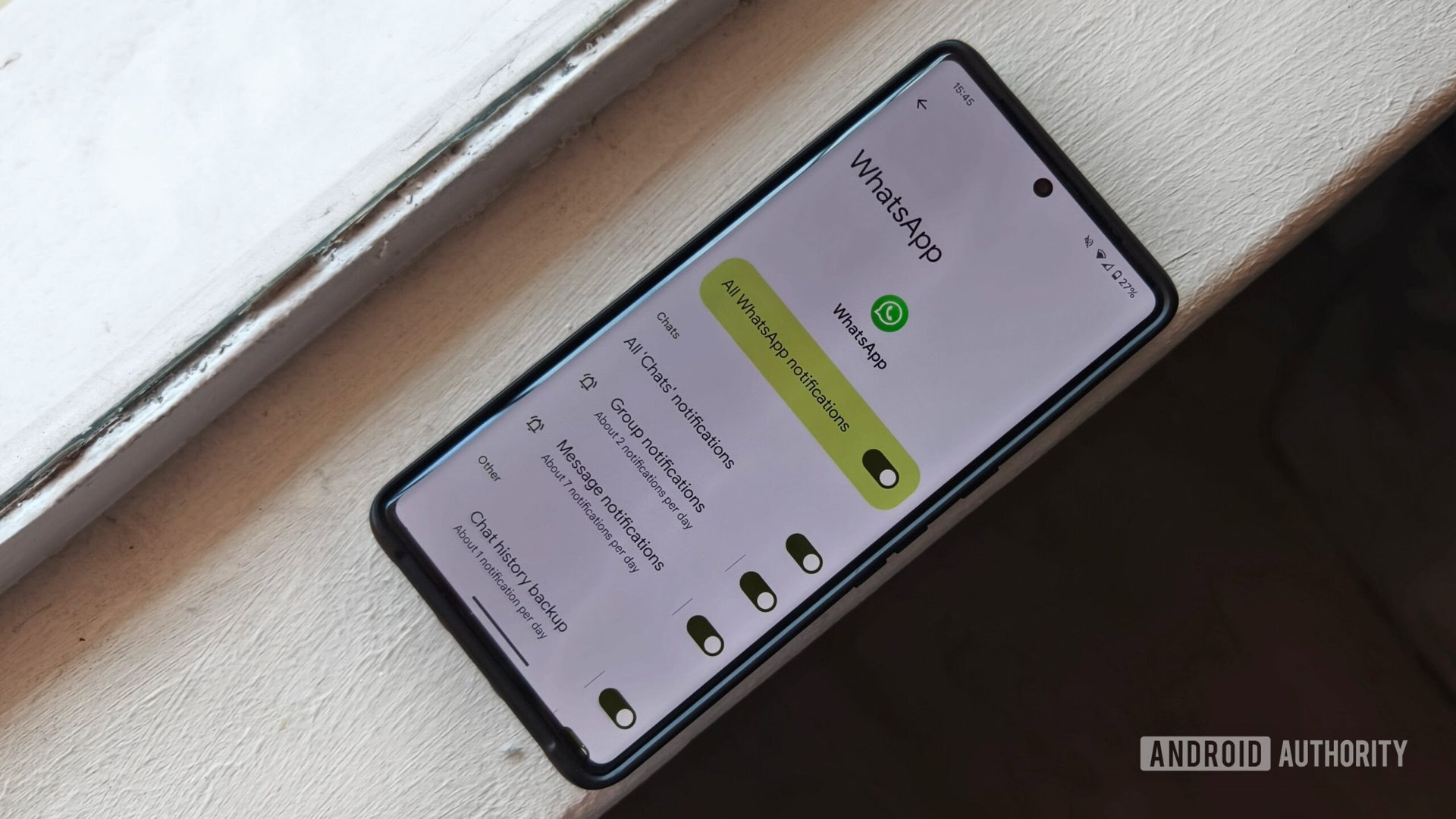




 English (US) ·
English (US) ·